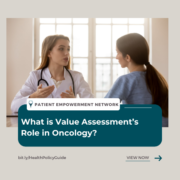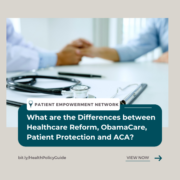What Is Value Assessment’s Role in Oncology?
What Is Value Assessment’s Role in Oncology? from Patient Empowerment Network on Vimeo.
Jennifer Bright, CEO of Innovation and Value Initiative discusses the role value assessment plays in oncology and explains how it can help get the best patient outcomes possible.
See More from the Health Policy Activity Guide
Transcript
Mary Leer:
What is value assessment/health technology assessments’ role in oncology?
Jennifer Bright:
Well, you know there’s a lot of evolution in the diagnosis and treatment of different cancers, whether it’s breast cancer or now that we have more understanding of biomarkers and things like that, that allow us to be more precise in our treatment of different cancers, there’s a lot of challenges in how do we look at the benefits and the costs, but then how do we weigh in individual experience, how do we bring in these biomarkers, how do we bring in novel therapies now that are very targeted to the individual when traditionally health technology assessment is very much focused on the average, how do we use clinical data, which is primarily about the average patient to answer questions that really have to do with precision medicine. But for oncology in particular, the benefit of looking at health technology assessment is really understanding as new therapies come to market as they, as new therapies arrive on a treatment landscape that has a lot of different options, value assessment can help us understand what are the comparative benefits for whom, and weigh the cost, and of course, cost is a big concern here in the US and globally.
We want to make sure that what we’re getting is the best patient outcomes for the best investment of our dollars, but what we also know is that, as I said before, the patient journey is very different, and so what might work for the average patient may not work for someone who is a different sub-group, whether that’s from gender or from race and ethnicity, or from age, or from severity of the cancer that we’re talking about, the nuance of that patient experience and their expectations for their care doesn’t get captured in this realm of health technology assessment, and so it makes it problematic to come up with conclusions that fit the need to make decisions, not necessarily at the clinical level, but when we think about health plans, about payers like Medicare or a commercial insurance plan, these entities are trying to figure out how do we use our resources to best effect for the health of the people we care for, the problem is if we’re using the average scientific data or the average patient experience, we may miss the mark for a lot of people, and so that’s one of the sticky parts of this field is, how do we find that balance point between coming up with a picture of benefit versus cost that fits the average situation versus when do we need to look at things that are more personalized and take into account things that are not well-understood in our clinical data.










